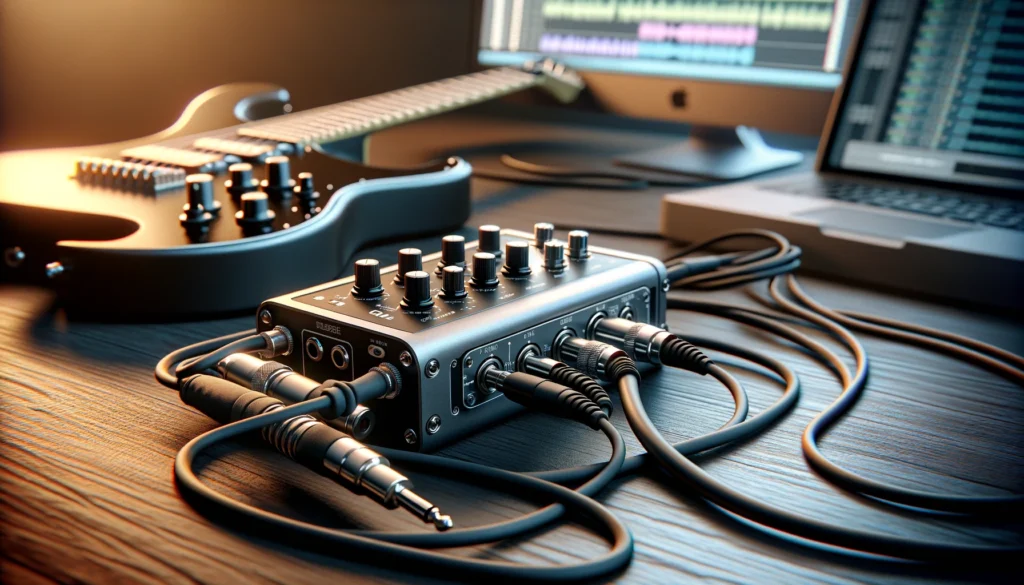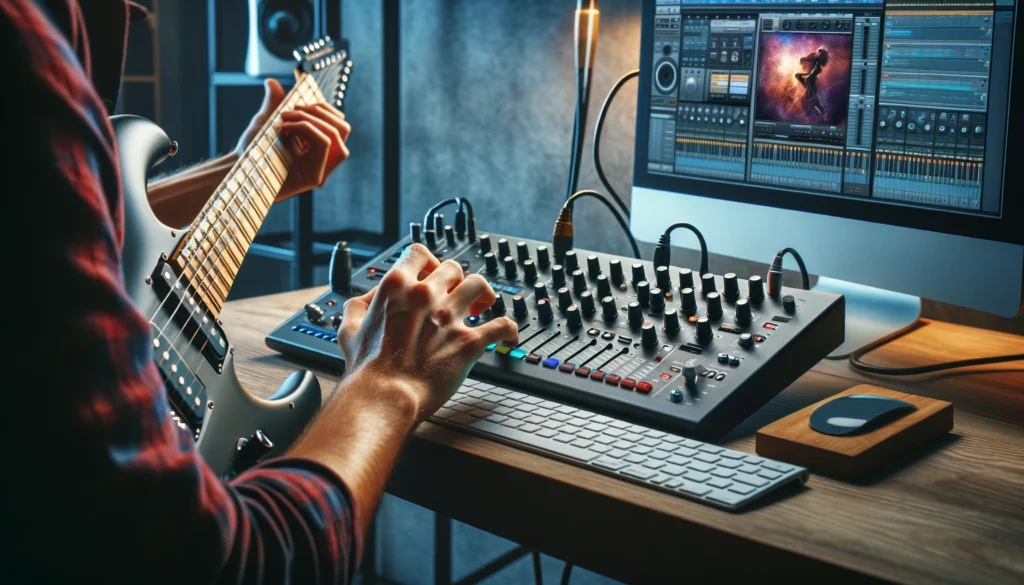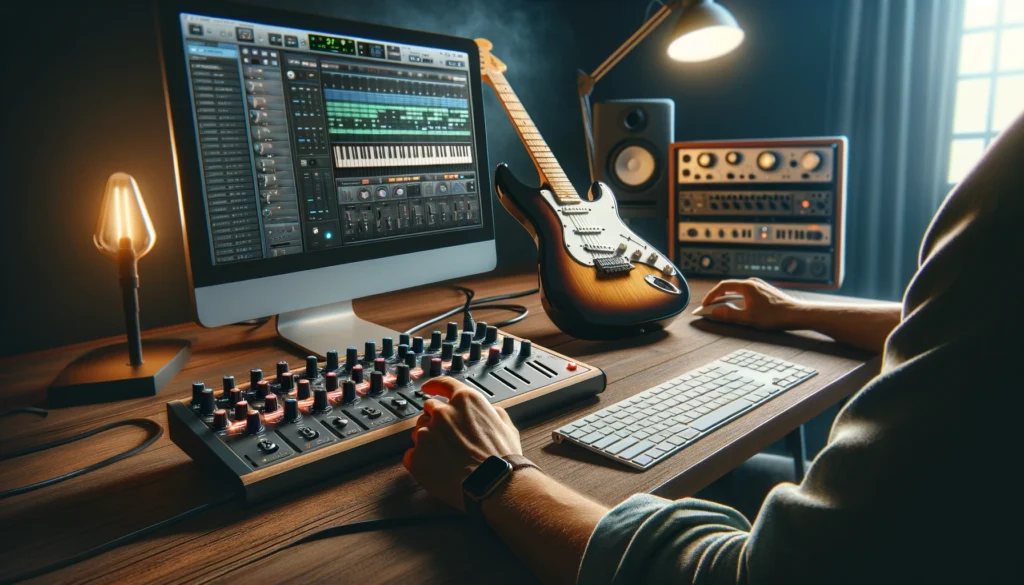Ever wondered how your favorite guitarists create such rich layers of synth textures and soundscapes that seem impossible with just a normal electric guitar?
By converting the guitar’s audio signal into MIDI data, you open up creative possibilities to use your trusty axe to play virtual instruments, sequence beats, manipulate MIDI effects, and more.
Let’s plug in and dive deeper into this guitar-to-MIDI world…
Can I Really Use My Guitar to Control MIDI?

Yes, modern pitch-to-MIDI converters and configurable MIDI mapping make it possible to harness guitar audio signals to manipulate MIDI instruments and effects.
But traditional electric guitars do have limitations vs MIDI keyboards for example.
Tracking glitches, limited polyphony control, and no velocity sensitivity mean the MIDI guitar workflow won’t be perfect.
However, optimizing playing dynamics and configuring converter settings properly will get surprisingly expressive, glitch-free MIDI manipulation from guitar.
We’ll explore setup steps and creative applications more below.
What is a MIDI Controller and How Can a Guitar Act As One?

A MIDI controller is a hardware device or software program that generates and transmits Musical Instrument Digital Interface (MIDI) data to control MIDI-enabled devices, such as virtual instruments and synthesizers.
MIDI data contains musical performance information like which notes are played, for how long, velocity, vibrato, and more.
A guitar can serve as a MIDI controller by converting the audio signals it outputs into digital MIDI information.
This lets you use your actual guitar playing to control plugins, synths, and MIDI instruments inside your recording software, opening up many possibilities for creative sound design, composition, and performance that go well beyond the guitar’s natural tone.
Special hardware or software analyzes the pitch of guitar notes you fret and pick and turns them into instructions that ultimately get sent as MIDI data specifying which notes to trigger on the receiving virtual instrument.
This MIDI data is relayed in real-time, tracking your playing with very little noticeable latency.
As long as your guitar is properly equipped and connected to facilitate this conversion process, you can control software synthesizers using nothing but your normal playing technique on the guitar.
Equipment You Need to Use Your Guitar As a MIDI Controller

Using your guitar as a MIDI controller requires some additional equipment beyond just having an electric guitar on hand.
At the minimum, you need:
A guitar-to-MIDI converter – This is a device or program that analyzes your guitar signal and translates your played guitar notes into MIDI data.
Options include both hardware devices as well as software plugins installed in a digital audio workstation (DAW):
– Hardware converters like the Roland GR, Axon AX100, or Jam Origin MIDI Guitar 2 connect between your guitar and computer to analyze pitch and convert to MIDI.
– Software options exist like Jam Origin’s mi.
Guitar or Native Instrument’s Guitar Rig that analyze your input signal internally and output MIDI data.
An audio interface – To get your guitar signal into your DAW or hardware MIDI converter box, you need an audio interface with a high impedance guitar input.
Better converters require a strong instrument level signal from your guitar to accurately detect pitch and convert to MIDI.
A Digital Audio Workstation (DAW) – MIDI data is typically sent to and recorded in a DAW like Ableton Live, Logic Pro, Pro Tools, etc.
The DAW also handles hosting virtual instruments which you’ll control with your converted guitar MIDI data.
Virtual instruments to play – Software synthesizers and MIDI samplers that receive the MIDI data complete the guitar to MIDI workflow, letting you trigger new sounds far beyond a normal guitar’s capabilities.
Without this equipment in the chain – specifically the piece that converts your guitar audio into MIDI information – you can’t harness a guitar for MIDI control of plugins, apps, and hardware.
How to Set Up Your Guitar for MIDI

With the proper interfaces and converter in place, setting up your guitar for effective MIDI control involves:
Connecting the Guitar Properly
Connect your guitar into your converter box or audio interface input using an instrument cable.
For hardware converters, follow the device manufacturer’s instructions for all connections – routing audio and converted MIDI data to and from the box into your computer and DAW.
For software DAW converters like plugins, connect your guitar directly to an audio interface input, then assign that interface input within the software and enable the guitar-to-MIDI conversion on the track.
Set the corresponding virtual instrument track/channel in your DAW to receive the generated MIDI data.
Configuring Software Settings
With hardware converters, install any required drivers and adjust device settings like input levels, MIDI channel assignments, pitch bend range, etc.
Software converters have fewer out-of-the-box settings, but parameters affecting tracking speed, MIDI channel assignments, and more should be configured in your DAW.
Set your guitar’s resulting MIDI channel to match the receiving virtual instrument track/channel.
Omni mode receiving may work for monitoring the unfiltered MIDI stream.
But to record parts, set the MIDI channel to avoid collision with other tracks.
Mapping the MIDI Conversion
You can specify how the guitar-to-MIDI system maps your playing into MIDI data using note and control change (CC) mapping editors.
For example, you may want:
– Open E tuned guitar to map MIDI note 60 (middle C) to the open low E string, then each fret above outputting MIDI note 61, 62, etc.
– Some MIDI CCs assigned to guitar effects pedal controls, whammy bar manipulation, or pressure sensing.
Properly calibrated mapping ensures in-key tracking so your guitar parts trigger musically useful MIDI data.
Some guitar-to-MIDI solutions auto-detect tuning and set relative mapping accordingly.
But you should still verify tracking alignment, adjust MIDI channel assignment, transpose octaves up/down, etc. in the settings before recording any MIDI tracks.
Playing and Recording MIDI with Your Guitar

Once everything is connected and configured, using a guitar to generate MIDI data is very straightforward in practice:
The Workflow
You simply play your guitar as normal while the converter device or software analyzes the live audio, translates that into MIDI instructions, and pipes that data into either external hardware synths or virtual instruments hosted in your DAW environment.
Those MIDI signals essentially mirror the notes and expressions you play to trigger sounds and get recorded to MIDI tracks.
You can overdub recordings using your normal guitar playing techniques – just as if you were recording standard instrument takes or using a keyboard MIDI controller.
Except now with the almost unlimited expandability of MIDI sound generation far beyond the guitar itself.
Optimizing the Conversion Tracking
No current solution offers perfectly flawless audio-to-MIDI conversion for guitar but you can optimize tracking confidence:
– Play very cleanly, keeping vibrato minimal, muting unused strings completely, and allowing notes to sustain more.
– Calibrate settings like analysis interval times and input gain staging for your playing dynamics and guitar/amp signal levels.
– Add some compression or EQ to the guitar signal chain to better detect pitch before hitting the converter. This makes for more stable MIDI conversion.
Adapting your mindset, guitar settings, and playing technique can drastically improve the MIDI tracking capabilities – even on economy guitar-to-MIDI solutions.
Creative Uses and Applications

With your guitar controlling MIDI instruments, you unlock many creative possibilities:
Using the Guitar to Drive Synths and Software Instruments
The most direct application is using your traditional electric guitar techniques to play virtual software synths, organ/piano/bell/string patches, beatboxes, and other MIDI instruments.
This takes you light years beyond the traditional sounds of a miked guitar amp or effects setup into almost unbounded sonic possibilities.
You can use familiar playing methods like shredding through scales/arpeggios on synth leads or using your volume control dynamics to shape pad swells and ambient cloud effects controlled by your actual hands on the strings.
Effects like sweeping filters, rhythmic auto-panners, and crazy delays and reverbs further mutate the triggered MIDI synth notes as you simultaneously adjust playing technique on the 6-string fretted physical controller.
Fingerpicking into Arps, Sequences, Glitch FX
Specialized MIDI effects processing expands your creative options even more as the converter forwards your raw guitar performance data as MIDI information rather than literal audio waveform clones.
Arpeggiators and note sequencers transform chords or lead runs into customizable riffing patterns.
Granular pitch/timing manipulation, endless sustains, and precise quantization all get applied downstream – freeing you to craft parts using the nuanced flow of playing a real guitar.
MIDI Envelope Tools and Expressive Control
Parameters like MIDI pitch bend, mod wheel, expression, sustain pedal data, and per-note modulation all generate from a guitar-to-MIDI converter pathway.
Subtleties of guitar technique control these continuous controller messages for shaping synths, especially when playing legato and adding dynamics like volume swells, bends, slides, vibrato and tremolo.
Envelopes filter synths and dynamically modulate effects in accordance with your pick attack transients, playing intensity, mute blending, and release characteristics.
That connection between hands-on expressiveness with a physical instrument and the power of MIDI mixing makes for a very intimate music creation experience.
Conclusion
Converting guitar audio into a MIDI data stream unlocks profound creative potential that the basic miked guitar/amp signal path could never offer.
With MIDI sound generation and processing now directly playable from your normal guitar technique, it’s like having a portal to unlimited sonic possibility at your fingertips.
Time to plug in your guitar and see what new dimensional worlds open up!
